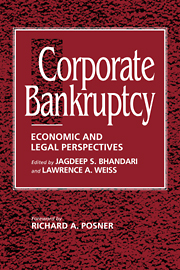Book contents
- Frontmatter
- Contents
- List of tables and figures
- Foreword by the HONORABLE RICHARD A. POSNER
- Preface
- Part I The role of credit
- Part II Bankruptcy as a reflection of the creditors' implicit bargain
- 4 A world without bankruptcy
- 5 Bankruptcy, nonbankruptcy entitlements, and the creditors' bargain
- 6 Translating assets and liabilities to the bankruptcy forum
- 7 Bankruptcy policy
- 8 Loss distribution, forum shopping, and bankruptcy: A reply to Warren
- Part III Beyond the basic creditors' bargain
- Part IV Workouts or bargaining in the shadow of bankruptcy
- Part V Alternatives to bankruptcy and the creditors' bargain
- Part VI Experience of other countries
- Index
5 - Bankruptcy, nonbankruptcy entitlements, and the creditors' bargain
Published online by Cambridge University Press: 10 December 2009
- Frontmatter
- Contents
- List of tables and figures
- Foreword by the HONORABLE RICHARD A. POSNER
- Preface
- Part I The role of credit
- Part II Bankruptcy as a reflection of the creditors' implicit bargain
- 4 A world without bankruptcy
- 5 Bankruptcy, nonbankruptcy entitlements, and the creditors' bargain
- 6 Translating assets and liabilities to the bankruptcy forum
- 7 Bankruptcy policy
- 8 Loss distribution, forum shopping, and bankruptcy: A reply to Warren
- Part III Beyond the basic creditors' bargain
- Part IV Workouts or bargaining in the shadow of bankruptcy
- Part V Alternatives to bankruptcy and the creditors' bargain
- Part VI Experience of other countries
- Index
Summary
Bankruptcy, at first glance, may be thought of as a procedure geared principally toward relieving an overburdened debtor from “oppressive” debt. Yet this discharge-centered view of bankruptcy is correct neither from an historical perspective nor from a realistic appraisal of the presence and operation of most of the provisions in the federal bankruptcy laws over the years. For although discharge of the debtor (and such related issues as “exemptions” that enable an individual debtor to keep assets out of the bankruptcy pool) may well be the motivating cause of a majority of bankruptcy cases, most of the bankruptcy process is in fact concerned with creditor–distribution questions. Assets are marshalled so that they can be allocated among those holding claims against the debtor or the debtor's property. Claims are determined so that participants in the allocation process may be assembled. And the rules governing priorities determine who, among the claimants, will get what and in what order.
Although the Bankruptcy Code specifies some of these priority rules claimants who fare best in the bankruptcy process hold special entitlements under applicable nonbankruptcy law. The priorities enunciated in the Bankruptcy Code itself deal largely with the allocation of rights among persons not entitled to preferential treatment outside of bankruptcy.
Despite the importance and durability of such distributional rules, no normative theory has been developed against which these intercreditor bankruptcy rules could be examined. This chapter will attempt to supply that theoretical analysis by exploring the role bankruptcy should play in shaping rules for distributions among creditors, and then testing certain existing rules against the resulting model.
- Type
- Chapter
- Information
- Corporate BankruptcyEconomic and Legal Perspectives, pp. 39 - 57Publisher: Cambridge University PressPrint publication year: 1996
- 3
- Cited by



